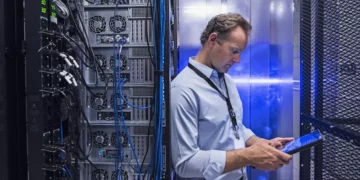<!—->
<!– –>

Sourcing is getting smarter. To start, many organizations have already pivoted from a tactical to a strategic sourcing mindset—which can make all the difference when it comes to gaining and retaining a competitive advantage.
Why? Because organizations with strategic sourcing mindsets look beyond price and cost savings-centered supplier selection initiatives. They instead focus on continuous improvement. They consider factors—like supplier performance or sustainability—that support long-term partnerships, advance business needs and increase purchasing power. Successful strategic sourcing often results in process optimization, cost management, customer satisfaction, risk management, increased sustainability and other benefits.
But now, the benefits of strategic sourcing are becoming even more attainable thanks to innovation. Here are four smart technologies modernizing strategic sourcing processes today:
Automation
Business process automation (also considered a type of business process outsourcing) is pervasive across industries, minimizing manual tasks in accounting, human resources, IT and more. Now, sourcing and procurement professionals are reaping the rewards of such automation: streamlining workflows, boosting the bottom line and finding efficiencies. Sourcing teams are automating processes like data analysis as well as supplier relationship management and transaction management.
For example, the IBM Sterling Transaction Manager automates manual transactions between businesses and suppliers. This helps reduce errors to improve data quality and response times to questions, which improves customer and supplier satisfaction. What’s more, automating transactions reduces the staff needed to onboard new suppliers, freeing them to focus on higher-value tasks.
Blockchain
Information is an invaluable business asset. Blockchain technology ensures that it’s stored, accessed and shared quickly, accurately and transparently. In sourcing strategy, blockchain technology helps track orders, payments, accounts and more.
For example, blockchain-backed contract management, when combined with automation, creates efficiencies and offers a high level of security. It works like this: “if/when…then…” statements are written into code on a blockchain. Then, when a predetermined condition is met and verified—such as releasing funds—the contract is executed immediately. Plus, blockchain transaction records are encrypted, making them incredibly difficult to hack or alter.
Learn more about Smart Contracts
More than 60% of Americans surveyed said they would pay up to a third more for products that are responsibly made and transparently sourced. In response to increasing expectations from customers and stakeholders alike, some businesses are leveraging the transparency and immutable record of blockchain to uphold their ethical and sustainable sourcing practices.
For instance, one company is using a network of trusted suppliers built on IBM Blockchain® to provide product provenance for sustainably sourced shrimp. Now, anyone can follow the full journey of a shrimp through the supply chain.
Learn more about IBM Food Trust
Advanced analytics and artificial intelligence (AI)
Analytics engines and their “big data brains” provide real-time sourcing flexibility and visibility to enhance order management and inventory systems. With cognitive intelligence in their toolbelts, sourcing teams can better understand and act on changes in the increasingly complex supplier market—as they happen. The ability to make these sourcing decisions in real-time can help increase profits during peak demand periods and better meet customer expectations. Try out cognitive intelligence free for 30-days.
In addition to enhanced decision-making, flexibility and visibility, analytics engines paired with AI can help manage supplier risk. For example, IBM Trust Your Supplier’s advanced analytics and AI continuously monitor suppliers’ regulatory compliance to enable a 24/7 trusted supplier network.
Another exciting use case for AI in sourcing can be found in smarter control towers. Traditional control towers can’t always provide visibility across silos, drive actions, integrate with third-party data and keep pace with ever-evolving modern supply chains. The next generation of control towers is powered by AI, with intelligent workflows and true end-to-end visibility to help forecast supply and demand fluctuations and navigate disruption.
How is sourcing strategy different than procurement strategy?
Often considered synonymous with the procurement process, sourcing is a distinct process within supply chain management. While procurement teams oversee the end-to-end process of acquiring goods and services, sourcing teams consider the “who,” or the providers and potential suppliers themselves. They handle upstream sourcing activities like contract negotiation, sending requests for proposals (RFPs) and requests for quotes (RFQs) as well as managing the supplier relationship once selected. However, due to their symbiosis, sourcing and procurement strategies often share similar initiatives, business goals and metrics.
Transforming your sourcing strategy
Building a strong sourcing strategy is critical for navigating the increasingly complex supply chain landscape. Strategic planning of supply chain processes requires technology, tools and partnerships that accelerate your goals—improving supply chain management, resiliency and sustainability.
Read our solution brief to get started.
Was this article helpful?
YesNo
More from Sustainability

February 20, 2024
Climate change predictions: Anticipating and adapting to a warming world
6 min read – In an era of accelerating climate change, predicting the near-future can yield major benefits. For instance, when utility officials are aware that a heat wave is on its way, they can plan energy procurement to prevent power outages. When farmers in drought-prone regions are able to predict which crops are susceptible to failure, they can deploy additional irrigation. These proactive measures are made possible by evolving technologies designed to help people adapt to the effects of climate change today. But…

February 19, 2024
Streamlining supply chain management: Strategies for the future
4 min read – In today’s complex global business environment, effective supply chain management (SCM) is crucial for maintaining a competitive advantage. The pandemic and its aftermath highlighted the importance of having a robust supply chain strategy, with many companies facing disruptions due to shortages in raw materials and fluctuations in customer demand. The challenges continue: one 2023 survey found 44% of companies had to make changes in the past year due to issues with their supply chain footprint, and 49% said supply chain…

February 15, 2024
Climate change examples
4 min read – What do global climate change and global warming look like? Surface temperature statistics paint a compelling picture of the changing climate: 2023, according to the European Union climate monitor Copernicus, was the warmest year on record—nearly 1.5 degrees Celsius warmer than pre-industrial levels. To gain a holistic understanding of the current climate crisis and future climate implications, however, it’s important to look beyond global average temperature records. The impacts of climate change may be organized into three categories: Intensifying extreme…
IBM Newsletters
Get our newsletters and topic updates that deliver the latest thought leadership and insights on emerging trends.
Subscribe now
More newsletters
- SEO Powered Content & PR Distribution. Get Amplified Today.
- PlatoData.Network Vertical Generative Ai. Empower Yourself. Access Here.
- PlatoAiStream. Web3 Intelligence. Knowledge Amplified. Access Here.
- PlatoESG. Carbon, CleanTech, Energy, Environment, Solar, Waste Management. Access Here.
- PlatoHealth. Biotech and Clinical Trials Intelligence. Access Here.
- Source: https://www.ibm.com/blog/sourcing-strategy/
- :is
- $UP
- 00
- 1
- 101
- 15%
- 19
- 2%
- 20
- 2023
- 2024
- 29
- 30-days
- 300
- 39
- 4
- 40
- 400
- 41
- 49
- 5
- 6
- 7
- 8
- 9
- a
- ability
- Able
- About
- accelerate
- accelerating
- accessed
- According
- Accounting
- Accounts
- accurately
- acquiring
- across
- Act
- actions
- activities
- adapt
- adapting
- addition
- Additional
- advance
- advanced
- ADvantage
- Advertising
- aftermath
- against
- AI
- alexandra
- alike
- All
- already
- also
- always
- Americans
- amp
- an
- analysis
- analytics
- and
- anticipating
- anyone
- ARE
- article
- artificial
- artificial intelligence
- AS
- asset
- At
- Attainable
- author
- automates
- automating
- Automation
- average
- aware
- back
- BE
- because
- becoming
- benefits
- Better
- between
- Beyond
- blockchain
- blockchain technology
- blockchain-backed
- Blog
- Blue
- boosting
- Bottom
- built
- business
- businesses
- button
- by
- CAN
- carbon
- card
- Cards
- case
- CAT
- categories
- Category
- Celsius
- chain
- chains
- challenges
- change
- Changes
- changing
- check
- circles
- class
- Climate
- Climate change
- climate crisis
- code
- cognitive
- color
- combined
- comes
- Companies
- company
- compelling
- competitive
- complex
- compliance
- condition
- Consider
- considered
- Container
- continue
- continuous
- continuously
- contract
- contract management
- control
- copy
- Cost
- Cost Management
- covered
- cracked
- creates
- crisis
- critical
- crops
- crucial
- CSS
- Current
- custom
- customer
- customer expectations
- Customer satisfaction
- Customers
- data
- data analysis
- data quality
- Date
- Decision Making
- decisions
- Default
- definitions
- deliver
- Demand
- deploy
- description
- designed
- desk
- difference
- different
- difficult
- Disruption
- disruptions
- distinct
- do
- drive
- due
- during
- Effective
- effects
- efficiencies
- emerging
- enable
- encrypted
- end-to-end
- energy
- Engines
- enhance
- enhanced
- ensures
- Enter
- Environment
- Era
- Errors
- Ether (ETH)
- European
- european union
- Even
- evolving
- example
- examples
- exciting
- executed
- Exit
- expectations
- facing
- Failure
- false
- farmers
- February
- finding
- Flexibility
- flood
- fluctuations
- Focus
- follow
- fonts
- food
- Footprint
- For
- Forecast
- found
- four
- Free
- freeing
- from
- full
- future
- Gain
- gaining
- generation
- generator
- get
- getting
- Global
- global business
- global warming
- Goals
- goods
- Grid
- hack
- had
- handle
- happen
- Have
- having
- Heading
- heat wave
- height
- help
- helpful
- helps
- here
- High
- Highlighted
- holistic
- However
- HTTPS
- huge
- human
- Human Resources
- IBM
- ICE
- ICO
- ICON
- image
- immediately
- immutable
- Impacts
- implications
- importance
- important
- improve
- improvement
- improves
- in
- Increase
- increased
- increasing
- increasingly
- incredibly
- index
- industries
- initiatives
- Innovation
- insights
- instance
- instead
- integrate
- Intelligence
- Intelligent
- intensifying
- into
- invaluable
- inventory
- iPad
- issues
- IT
- ITS
- journey
- jpg
- Keep
- landscape
- large
- latest
- Leadership
- Level
- levels
- leveraging
- like
- Line
- local
- locale
- long-term
- Look
- look like
- looking
- made
- maintaining
- major
- make
- Making
- manage
- management
- managing
- manual
- many
- materials
- max-width
- May..
- measures
- Meet
- met
- Metrics
- min
- minimizing
- minutes
- Mobile
- Modern
- modernizing
- Monitor
- more
- moving
- Navigate
- navigating
- Navigation
- needed
- needs
- negotiation
- network
- New
- Newsletters
- next
- nothing
- now
- of
- off
- Offers
- officials
- often
- on
- Onboard
- once
- ONE
- optimization
- optimized
- or
- order
- orders
- organizations
- Organized
- Other
- our
- out
- Outages
- overhead
- oversee
- Pace
- page
- paint
- paired
- pandemic
- partnerships
- past
- Pay
- payments
- Peak
- People
- performance
- periods
- person
- PHP
- picture
- plan
- planning
- plato
- Plato Data Intelligence
- PlatoData
- plugin
- plus
- policy
- position
- possible
- Post
- potential
- power
- practices
- predict
- predicting
- Predictions
- prevent
- price
- primary
- Proactive
- process
- Process Automation
- processes
- procurement
- Product
- Products
- professionals
- profits
- propelled
- Proposals
- provenance
- provide
- providers
- purchasing
- quality
- Questions
- quickly
- quotes
- Raw
- Reading
- real-time
- reaping
- record
- records
- reduce
- reduces
- regions
- regulatory
- Regulatory Compliance
- relationship
- Relationship Management
- releasing
- requests
- requires
- Resources
- response
- response times
- responsibly
- responsive
- Results
- retaining
- Rewards
- Risk
- robots
- robust
- s
- Said
- satisfaction
- Screen
- scripts
- security
- selected
- selection
- sending
- seo
- Services
- Share
- shared
- shortages
- silos
- similar
- site
- small
- smart
- smarter
- snow
- solution
- some
- sourced
- Sourcing
- Sponsored
- squares
- Staff
- stakeholders
- start
- started
- statements
- statistics
- sterling
- stored
- Strategic
- strategies
- Strategy
- streamlining
- strong
- studio
- subscribe
- successful
- such
- supplier
- suppliers
- supply
- Supply and Demand
- supply chain
- supply chain management
- Supply chains
- support
- Surface
- Survey
- susceptible
- Sustainability
- sustainable
- SVG
- synonymous
- Systems
- tactical
- tasks
- teams
- Technologies
- Technology
- tertiary
- than
- thanks
- that
- The
- The Future
- their
- Them
- theme
- themselves
- then
- These
- they
- Third
- third-party
- third-party data
- this
- thought
- thought leadership
- three
- Through
- time
- times
- Title
- to
- today
- tools
- top
- topic
- track
- traditional
- transaction
- Transactions
- Transparency
- transparently
- Trends
- true
- Trust
- trusted
- type
- understand
- understanding
- union
- Updates
- Uphold
- URL
- use
- use case
- using
- utility
- View
- visibility
- W
- Warehouse
- Warmer
- was
- Waters
- Wave
- Way..
- WELL
- when
- which
- while
- wind
- with
- within
- WordPress
- worker
- workflows
- works
- world
- would
- written
- year
- Yield
- young
- Your
- zephyrnet












